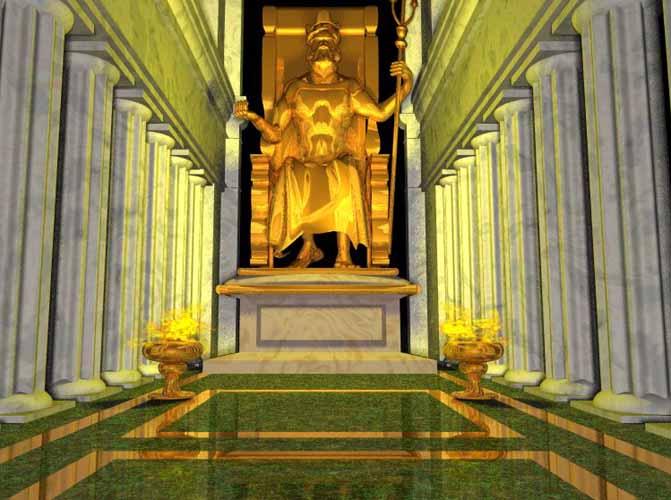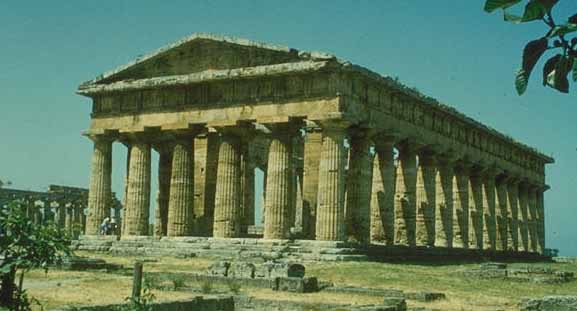
- Description
The seated statue, some 12 meters (39 feet) tall, occupied the whole width of the aisle of the temple built to house it. "It seems that if Zeus were to stand up," the geographer Strabo noted early in the first century BC, "he would unroof the temple." Zeus was a chryselephantine sculpture, made of ivory and gold-plated bronze. No copy, in marble or bronze, has survived, though there are recognizable but approximate versions on coins of Elis and Roman coins and engraved gems but a very detailed description of the sculpture and the throne was recorded by the traveller Pausanias, in the second century AD. In the sculpture, he was wreathed with shoots of olive and seated on a magnificent throne of cedarwood, inlaid with ivory, gold, ebony, and precious stones. In Zeus' right hand there was a small statue of crowned Nike, goddess of victory, also chryselephantine, and in his left hand, a sceptre inlaid with metals, on which an eagle perched. Plutarch, in his Life of the Roman general Aemilius Paulus, records that the victor over Macedon, when he beheld the statue, “was moved to his soul, as if he had beheld the god in person,” while the Greek orator Dio Chrysostom declared that a single glimpse of the statue would make a man forget his earthly troubles.The date of the statue, in the third quarter of the fifth century BC, long a subject of debate, was confirmed archaeologically by the rediscovery and excavation of Phidias' workshop.
According to a legend, when Phidias was asked what inspired him -- whether he climbed Mount Olympus to see Zeus, or whether Zeus came down from Olympus so that Phidias could see him -- the artist answered that he portrayed Zeus according to Book One, verses 528 - 530 of Homer´s Iliad:
ἦ καὶ κυανέῃσιν ἐπ' ὀφρύσι νεῦσε Κρονίων
ἀμβρόσιαι δ' ἄρα χαῖται ἐπερρώσαντο ἄνακτος
κρατὸς ἀπ' ἀθανάτοιο μέγαν δ' ἐλέλιξεν Ὄλυμπον.
He spoke, the son of Kronos, and nodded his head with the dark brows,
and the immortally anointed hair of the great god
swept from his divine head, and all Olympos was shaken.
The sculptor also was reputed to have immortalized his eromenos, Pantarkes, by carving "Pantarkes kalos" into the god's little finger, and placing a relief of the boy crowning himself at the feet of the statue.
Zeus in Greek mythology is the king of the gods, the ruler of Mount Olympus, and god of the sky and thunder. His symbols are the thunderbolt, eagle, bull and the oak. In addition to his Indo-European inheritance, the classical Zeus also derives certain iconographic traits from the cultures of the ancient Near East, such as the scepter. Zeus is frequently envisaged by Greek artists in one of two poses: standing, striding forward, a thunderbolt leveled in his raised right hand, or seated in majesty.
The son of Cronus and Rhea, he was the youngest of his siblings. He was married to Hera in most traditions, although at the oracle of Dodona his consort was Dione: according to the Iliad, he is the father of Aphrodite by Dione. Accordingly, he is known for his erotic escapades, including one pederastic relationship with Ganymede. His trysts resulted in many famous offspring, including Athena, Apollo and Artemis, Hermes, Persephone (by Demeter), Dionysus, Perseus, Heracles, Helen, Minos, and the Muses (by Mnemosyne); by Hera he is usually said to have sired Ares, Hebe and Hephaestus.
- Birth
After reaching manhood, Zeus forced Cronus to disgorge the other children in reverse order of swallowing: first the stone, which was set down at Pytho under the glens of Parnassus to be a sign to mortal men, then the rest. In some versions, Metis gave Cronus an emetic to force him to disgorge the babies, or Zeus cut Cronus' stomach open.
Then Zeus released the brothers of Cronus, the Gigantes, the Hecatonchires and the Cyclopes, from their dungeon in Tartarus (The Titans; he killed their guard, Campe. As gratitude, the Cyclopes gave him thunder and the thunderbolt, or lightning, which had previously been hidden by Gaia.) Together, Zeus and his brothers and sisters, along with the Gigantes, Hecatonchires and Cyclopes overthrew Cronus and the other Titans. The Titans were then cast into a shadowy underworld region known as Tartarus.
After the battle with the Titans, Zeus shared the world with his elder brothers, Poseidon and Hades, by drawing lots: Zeus got the sky and air, Poseidon the waters, and Hades the world of the dead (the underworld). Land was left to all three, each according to their capabilities, which explains why Poseidon was the "earth-shaker" (the god of earthquakes) and Hades claimed the humans that died.
Gaia was upset at the way Zeus had treated the Titans, because they were her children. Soon after taking the throne as king of the gods, Zeus had to fight some of Gaia's other children, the monsters Typhon and Echidna. He vanquished Typhon and trapped him under a mountain, but left Echidna and her children alive as challenges for future heroes.

Niciun comentariu:
Trimiteți un comentariu